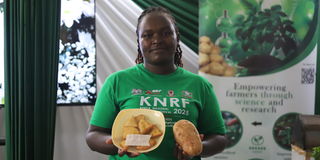Egerton student discovers wonders of potato flour

Jackline Syombua,a Science and Soil Science Master's student at Egerton University, displays her Potato Mandazi on August 19 during the Kenya National Research Festival 2025.
For many Kenyans, potatoes are a familiar staple, often fried, boiled, or mashed.
But for Jackline Syombua, a Science and Soil Science Master's student at Egerton University, the humble potato is more than just food. It is a raw material with untapped potential for value addition.
In an interview with Mtaa Wangu during the Kenya National Research Festival 2025, Syombua explained how she is experimenting with potato flour to develop alternative food products, among them potato mandazi.
“To get potato flour, you start by peeling and cleaning the potatoes. Then you slice them into very thin pieces so that they can dry faster. After drying, which usually takes about 72 hours depending on the weather, you mill them in the poshomil just like maize or blend the dried potatoes in a blender for those doing it on a small scale. That’s how you get fine potato flour,” she explains.
Potato flour, Syombua says, has advantages over wheat flour, which dominates the Kenyan market.
Unlike wheat, potatoes have no known allergy concerns and the flour is also gluten free. Additionally, using potato flour helps diversify the country’s food system.
Still, potato flour has its own limitations. Because it lacks stickiness (Binding factor), it is often blended with other flours to achieve better results when preparing mandazi.
“For mandazi, I use a 70:30 ratio, 70 percent potato flour and 30 percent wheat flour. Alternatively, for people with gluten sensitivities, you can replace wheat with corn starch. However, when baking you can use pure potato flour. The blending is only needed when you are deep frying the food you are preparing,” Syombua adds.
She notes the process of making mandazi can also work with raw potatoes on a small scale. As she explains, you peel, boil, and mash the potatoes before mixing them with 30 percent corn or wheat flour and frying them into soft, golden mandazis.
The idea, Syombua reveals, started in May this year as part of her food innovation journey. She notes, while the potato mandazi is not yet on supermarket shelves, the local market response has been encouraging.
“Acceptance is at about 80%. People are curious to try something different. They find potato mandazi unique, and this curiosity is creating demand,” she notes.
For Syombua, value addition is more than just business, it is about rethinking how Kenyans consume potatoes and how farmers can benefit from new markets.
“Potato flour has the potential to change how we use this crop. It’s not just about fries or crisps anymore. With more innovation, we can create healthier and more diverse products for the market,” she says.
Other than mandazi she has also been making potato waffles , bajiahs , potato rolls ,Potato chips which are already out in the market just to present available options potatoes can offer. Her products are currently being sold around Egerton.
As she continues her research, Syombua hopes to scale up production and introduce potato-based products that can stand alongside wheat-based goods in shops and supermarkets. For her, the journey of turning potatoes into mandazi is only the beginning.
During the official opening of the festival the Principal Secretary for Science, Research, and Innovation Prof. Shaukat Abdulrazak, stressed on the need for research to improve livelihoods in the country.
“Research is the bridge between our laboratories and our farms. It is through science, research and innovation that we can enhance food production, ensure food security and sovereignty, and provide solutions to the challenges facing our society. That is why collaboration between universities, research institutions, farmers and government is critical to turn knowledge into action and make science meaningful to the everyday lives of Kenyans,” says Prof.Abdulrazak.


